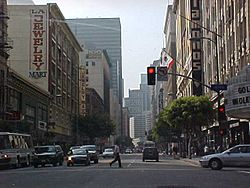Jewelry District (Los Angeles) facts for kids
Quick facts for kids
Jewelry District
|
|
|---|---|

Street level in the Jewelry District, on Seventh Street, facing West and the Financial District
|
|
| Country | |
| State | |
| County | County of Los Angeles |
| City | |
| Area code(s) | 213 |
The Jewelry District is a special part of Downtown Los Angeles. It's famous for selling all sorts of beautiful jewels and shiny things. Imagine a whole neighborhood dedicated to sparkling treasures!
Contents
A Glimpse into the Past: History of the District
Most buildings in the Jewelry District are quite old. They were built in the early 1900s. This was a time when more and more cars appeared in Los Angeles.
About half of this area is part of the larger "Historic Core" of Downtown Los Angeles. This historic part stretches between Hill and Main Streets, from 3rd to 9th streets. Many buildings here were built around 1923. The oldest one still standing is at 543 South Broadway Avenue. It's a three-story building that now houses Teresa's Bridals.
Tall Buildings and City Growth
Many buildings in the Jewelry District were first designed as offices. They often had shops on the ground floor. A famous example is the historic Loew’s State Theatre, built in 1923.
In the early 1900s, Downtown Los Angeles was growing fast. However, its buildings weren't as tall as the skyscrapers in Chicago or New York. A law limited buildings to 150 feet (about 45 meters) high. Architects and city planners liked this rule. They thought super tall buildings were not good for the Southern California lifestyle. They believed too many tall buildings would make the city too crowded. But many people still loved the area, which helped businesses grow.
How the Jewelry District Sparkled to Life
The Jewelry District really started to shine after the 1960s. This was when people began to see gold as a safer investment than money. Gold became very popular, not just for its value, but also for its style.
Before this big boom, the California Jewelry Mart was a major player. It was located at 607 S. Hill Street. The district became even more famous when the Saint Vincent Jewelry Center opened. This center is still in a large building from 1923. It even has a European-style alley with restaurants.
Right across from St. Vincent's is the State Theater Building. This is a twelve-story red brick office building and theater. It was designed in 1921. Near Loew's Theatre, there was another office building that had a drug store in the early 1900s.
Behind Loew's, on 7th Street, you'll find the Speckels building. This used to be an office building but became a place for making clothes. Also nearby was the Provident Loan Association. This was a non-profit group that gave short-term loans for gold and jewelry. It was one of the last groups of its kind from the late 1800s and early 1900s.
Another interesting building is the Jasper building at 728 S. Hill Street. It's a 14-story office building built in 1928. It was later changed to become another jewelry making center.
One special historic place being restored is Clifton's Cafeteria at 648 South Broadway. Its original look from 1904 is being brought back. For 50 years, it had a modern metal cover. This cover was added in 1963 to help the cafeteria compete with newer restaurants in the city's suburbs. Before Clifton's, this spot was home to Boos Brothers Cafeteria until Clifton bought it in 1935.
Getting Around: Transportation to the District
You can easily reach the Los Angeles Jewelry District using public transportation. Take the Metro B Line to the Pershing Square station. The Jewelry District is just southeast of the square.

